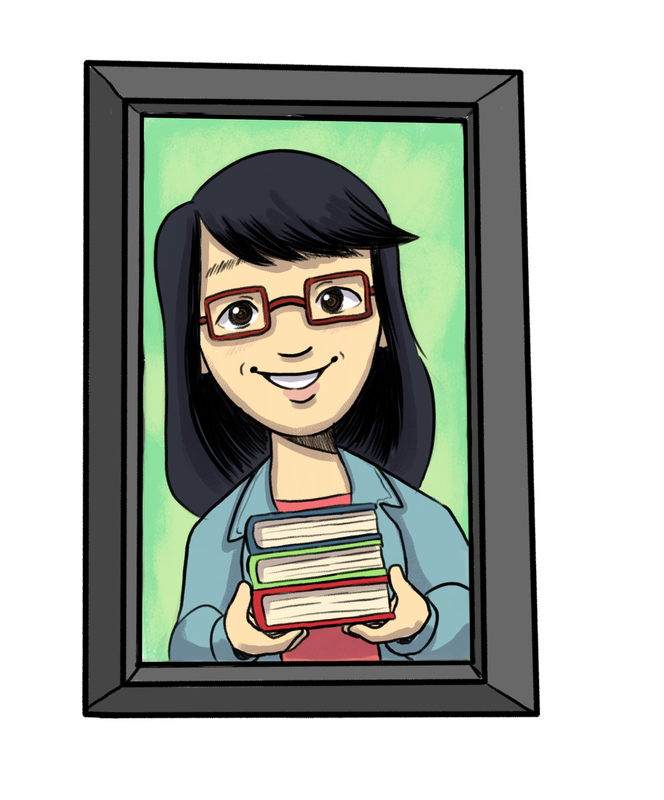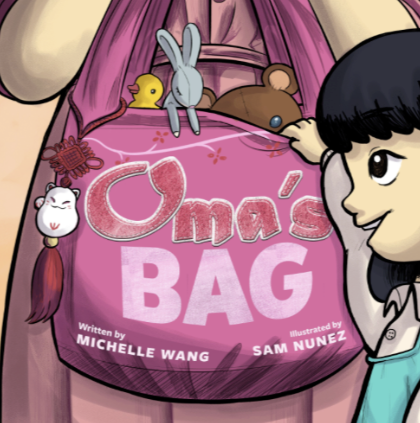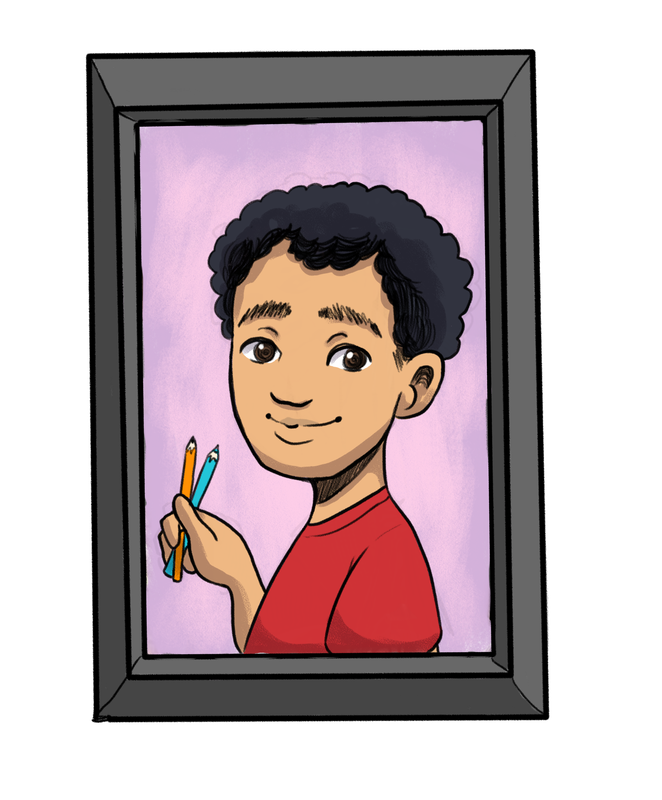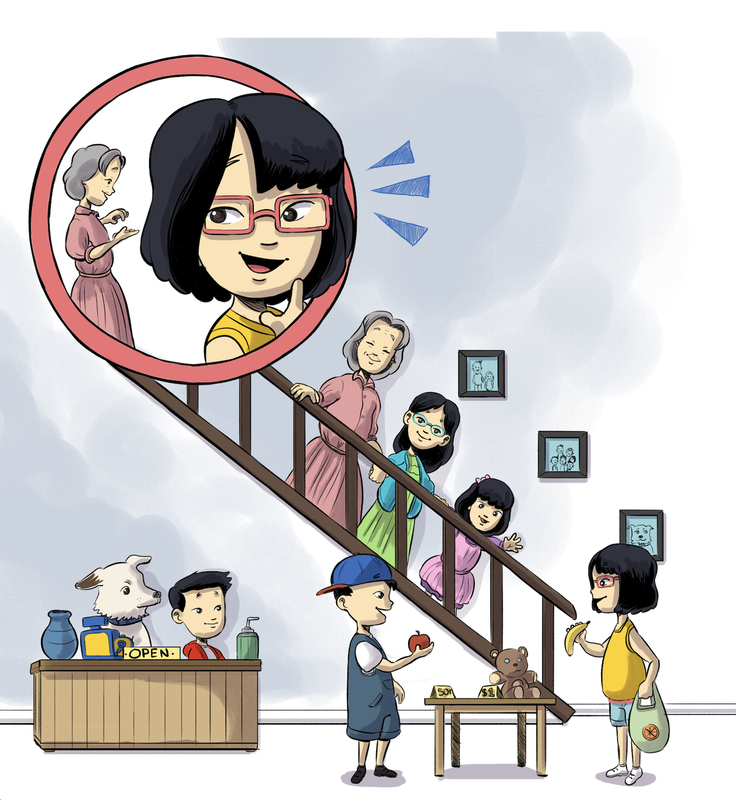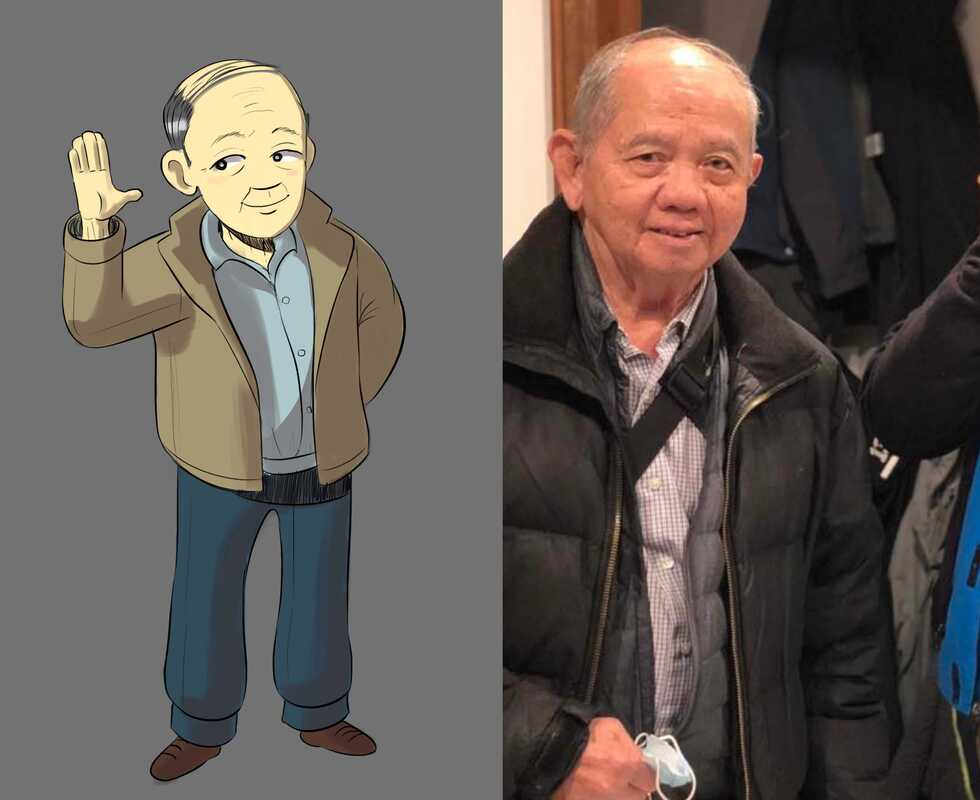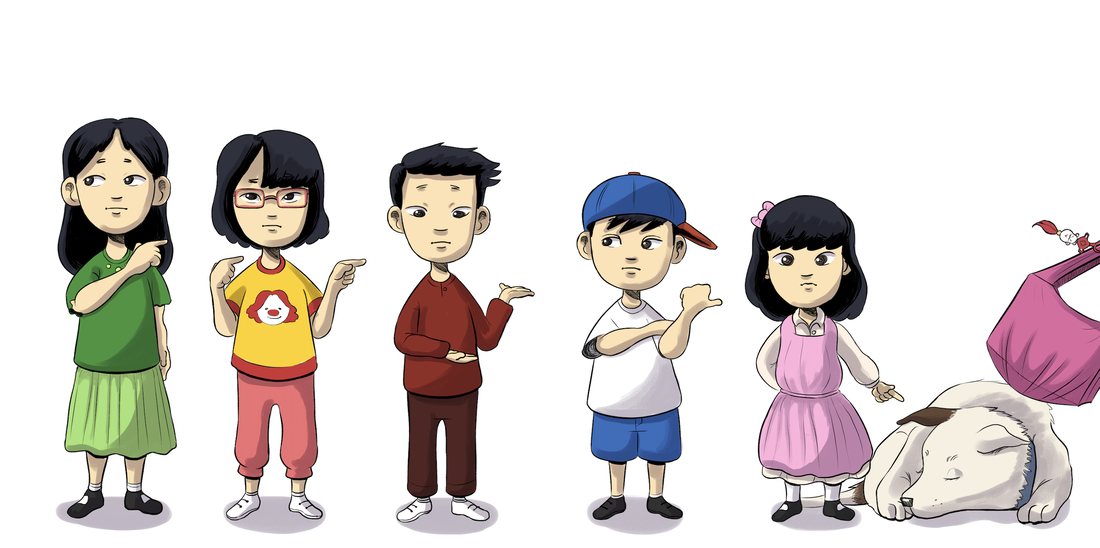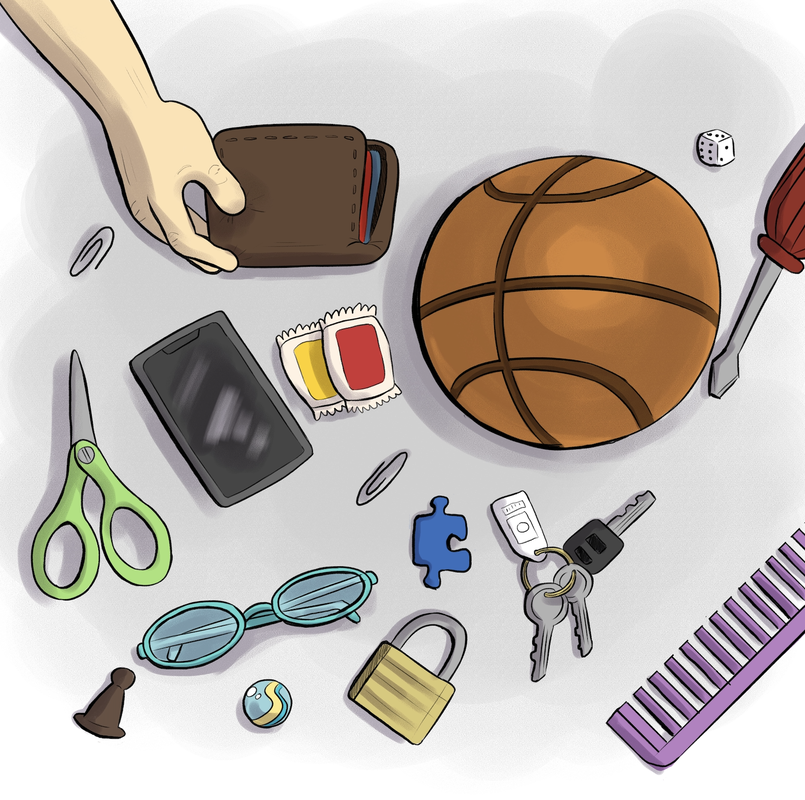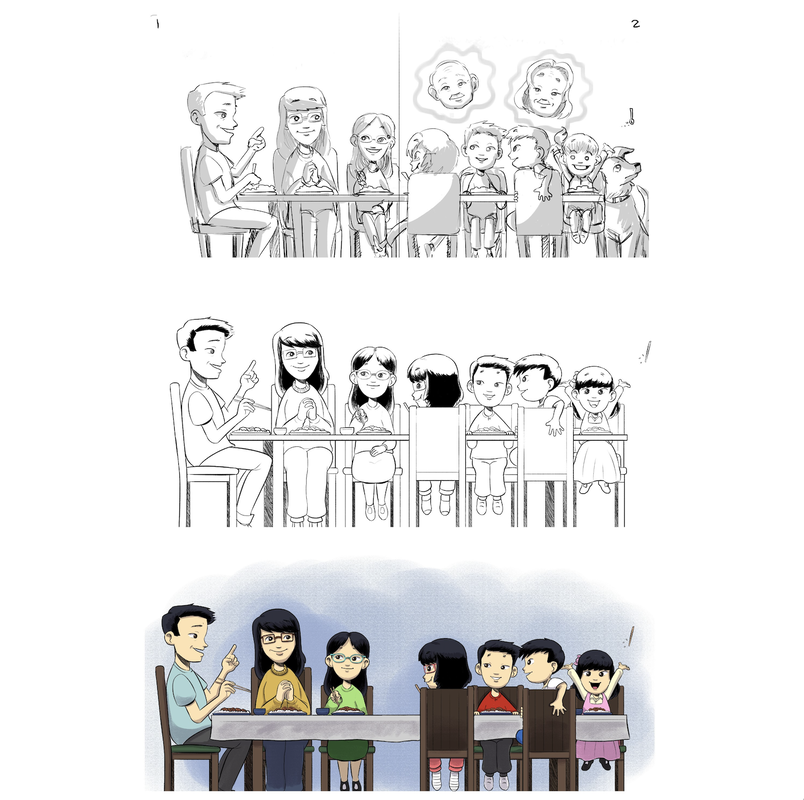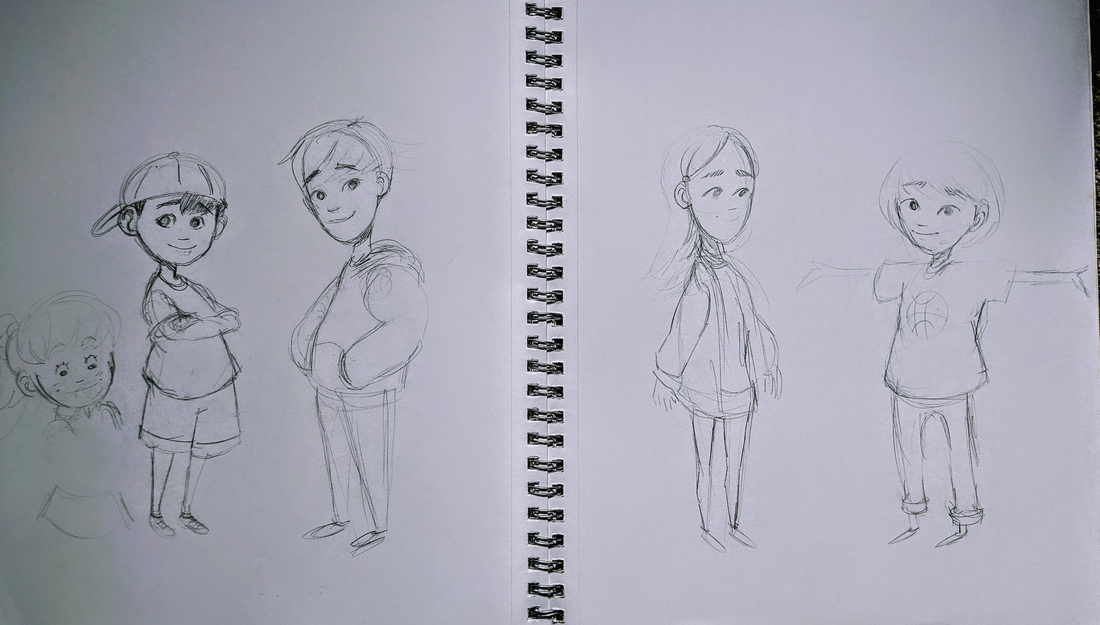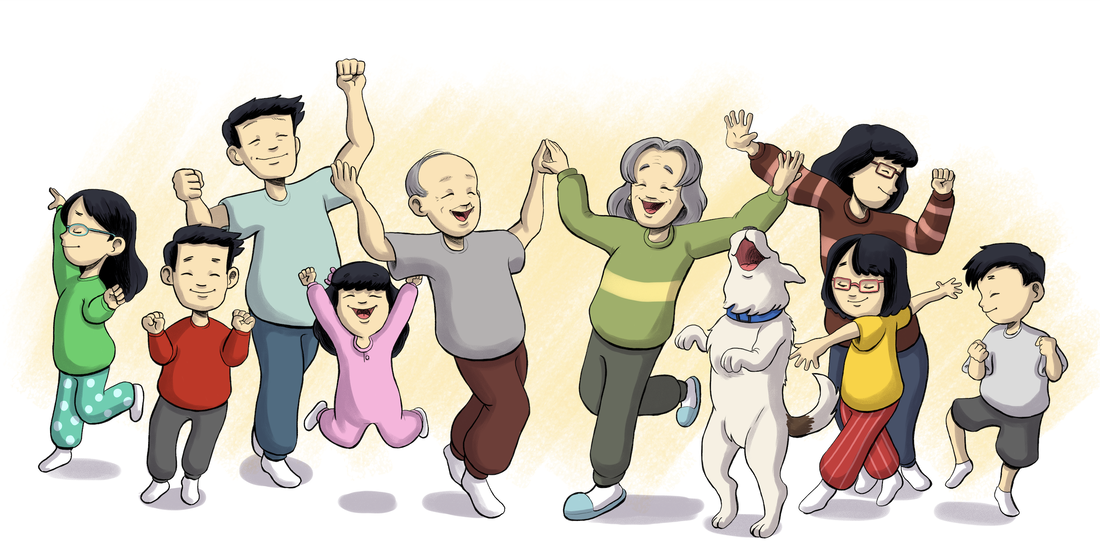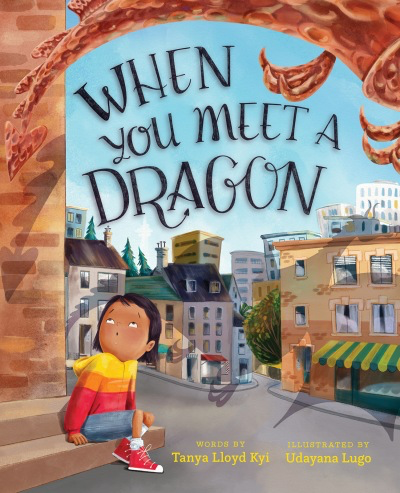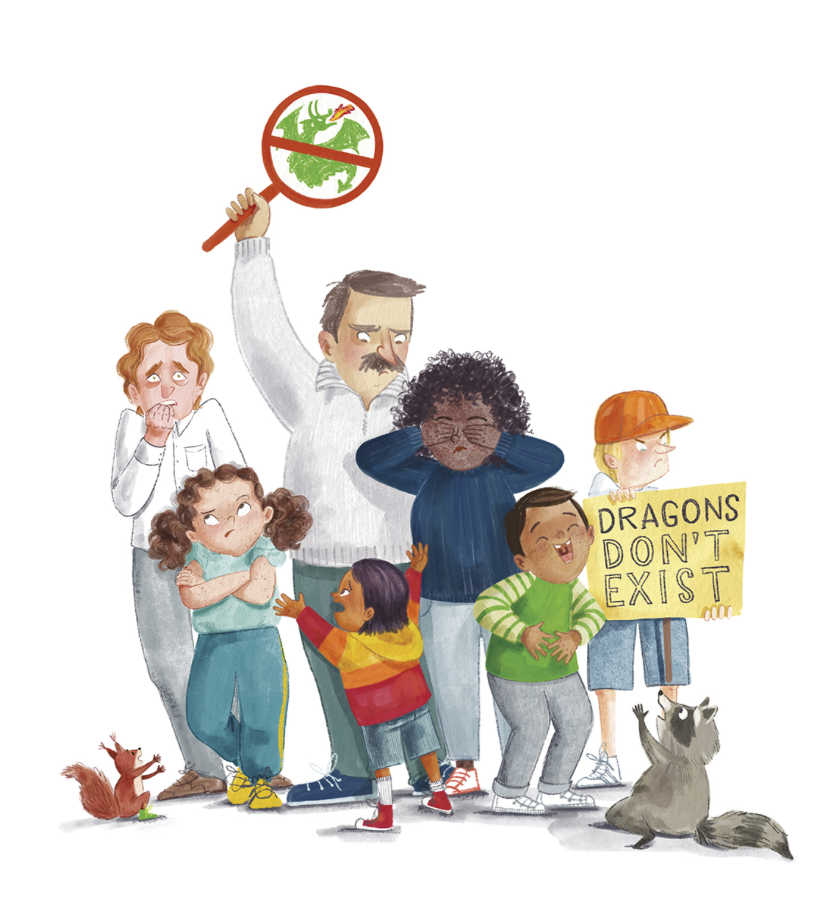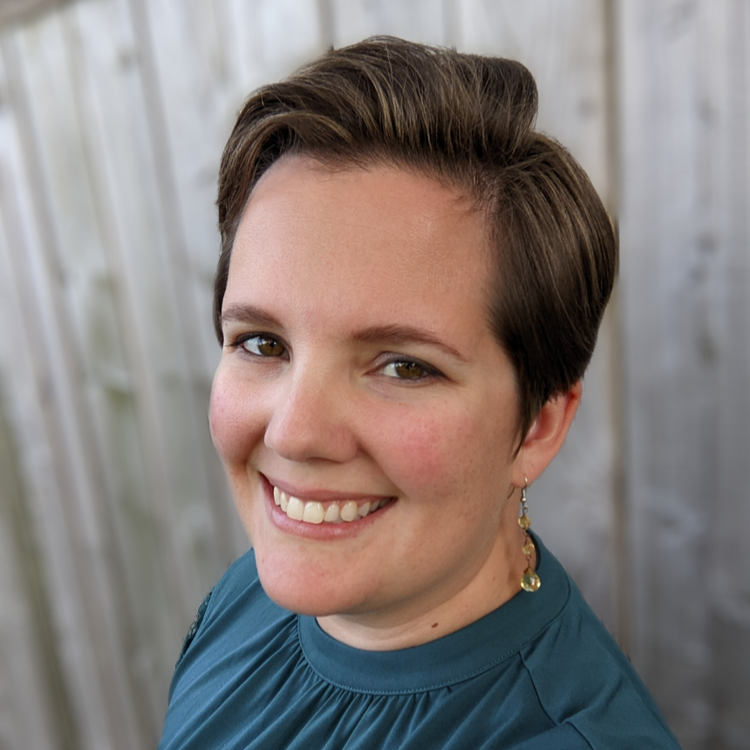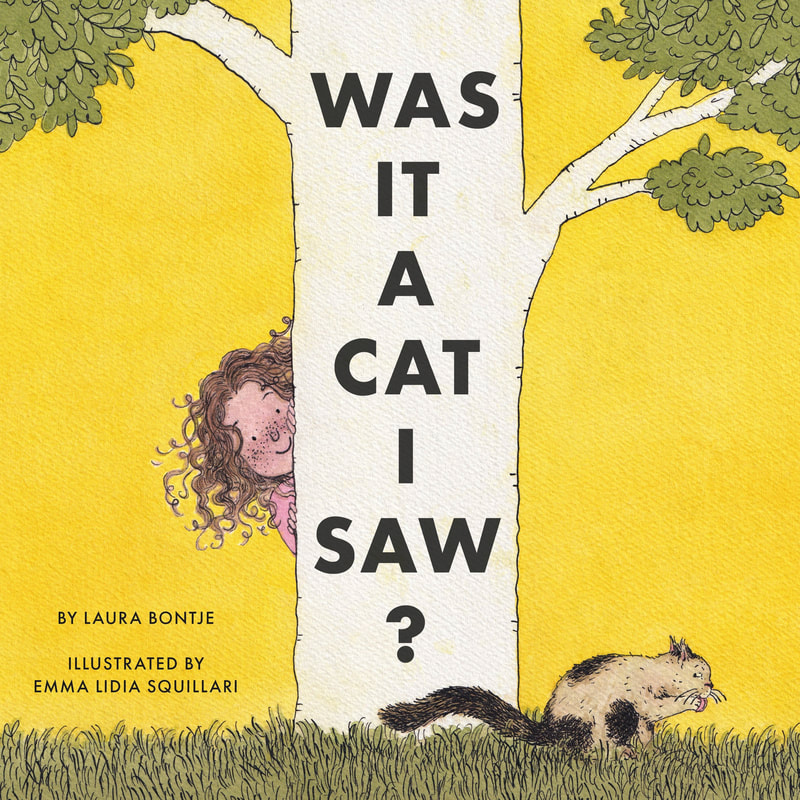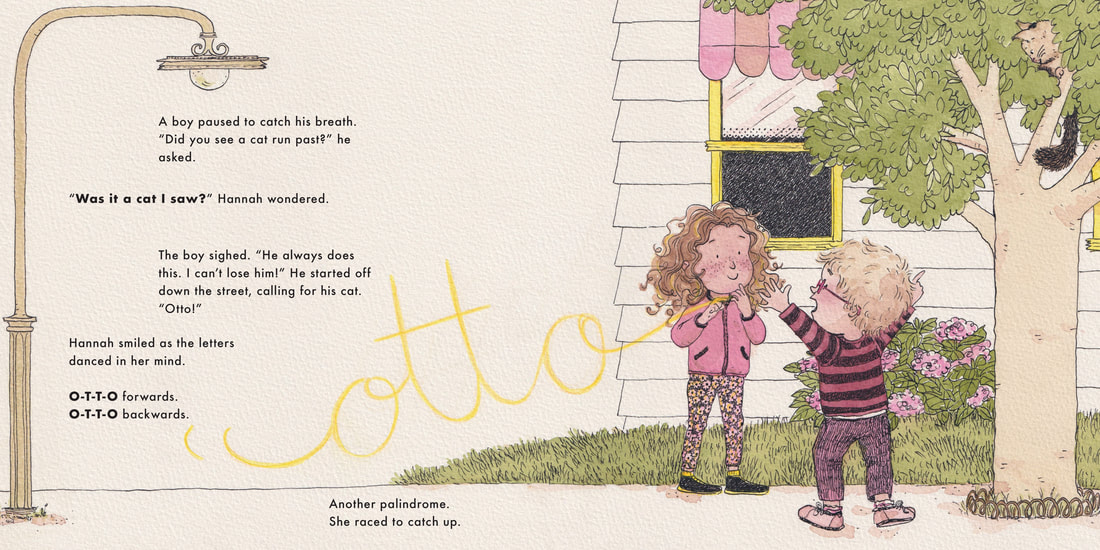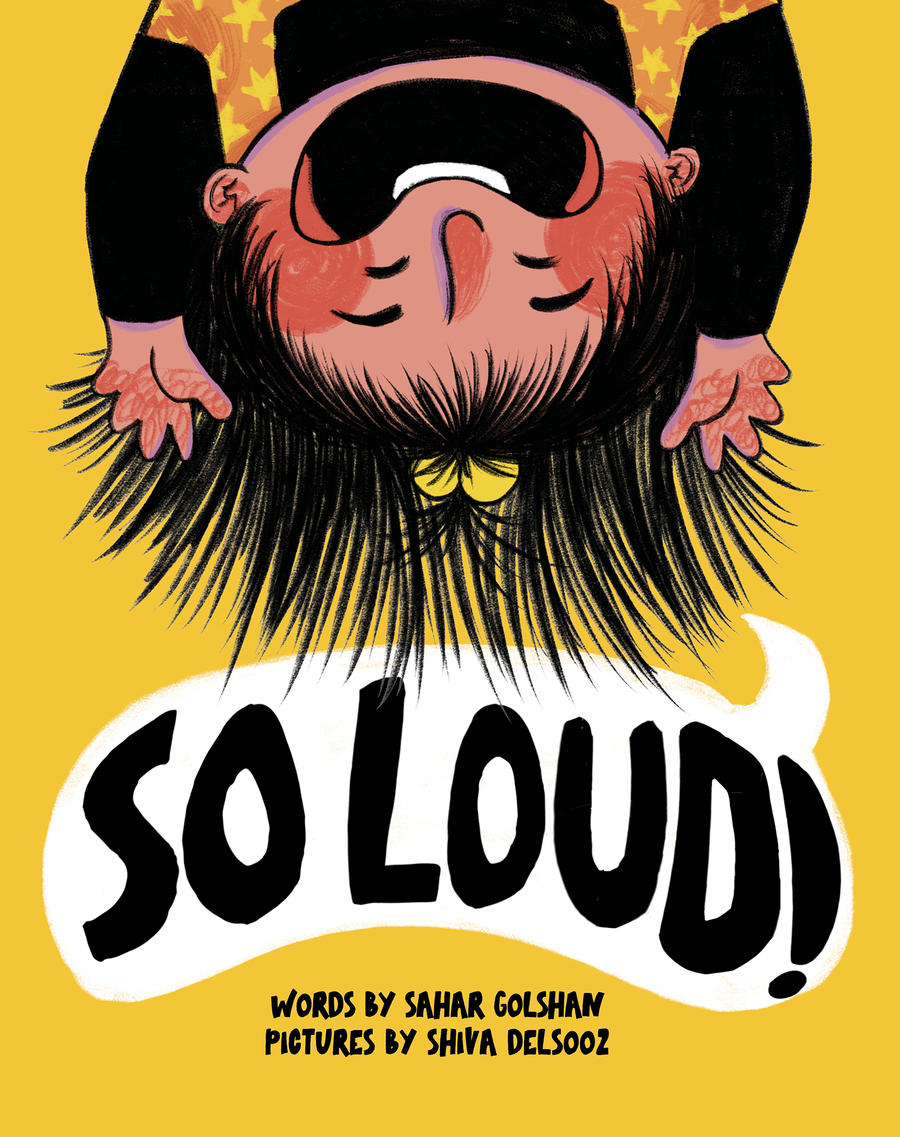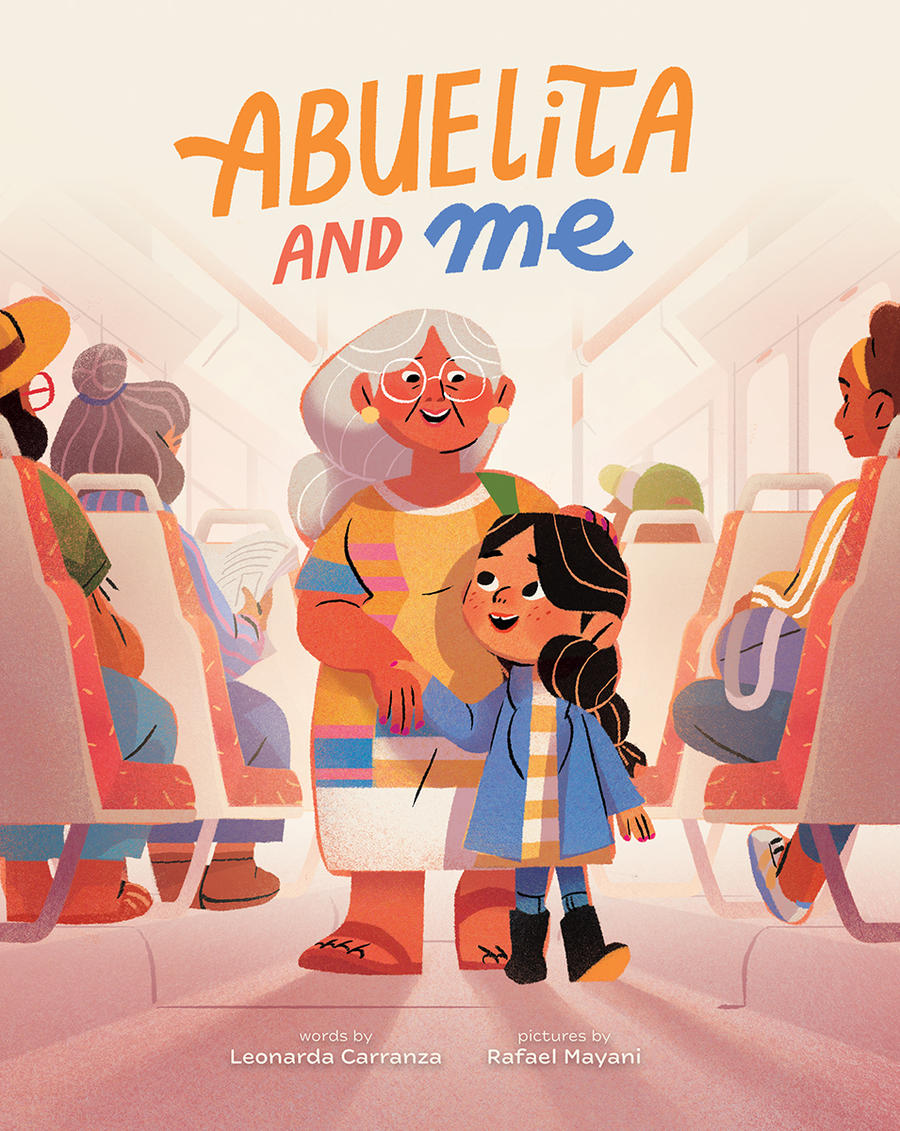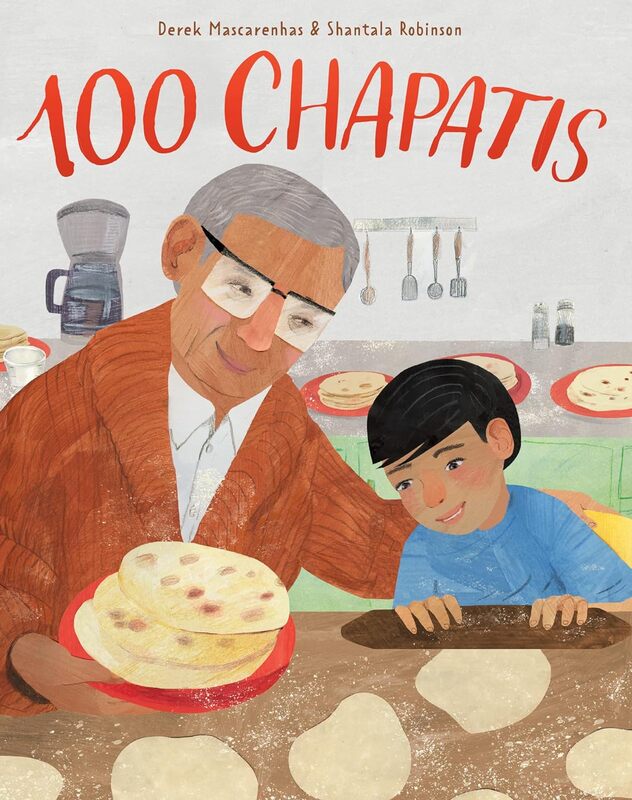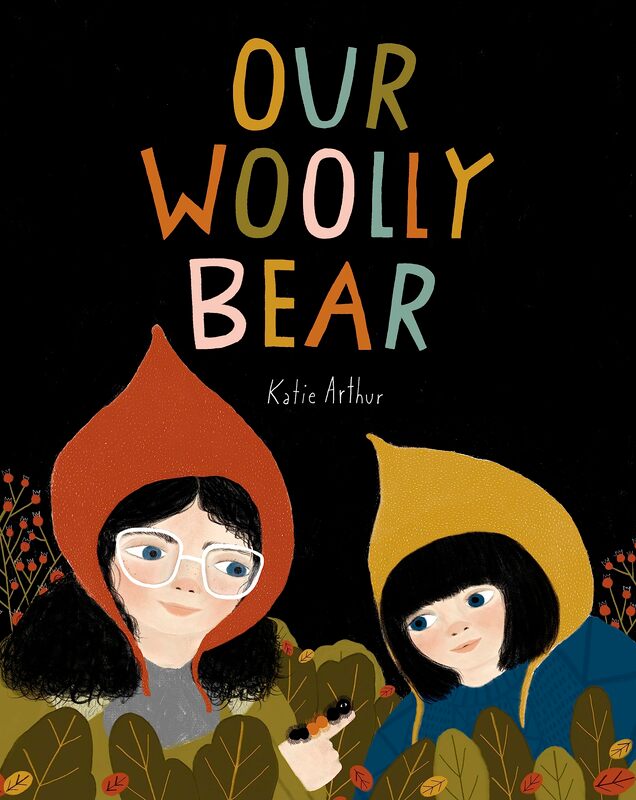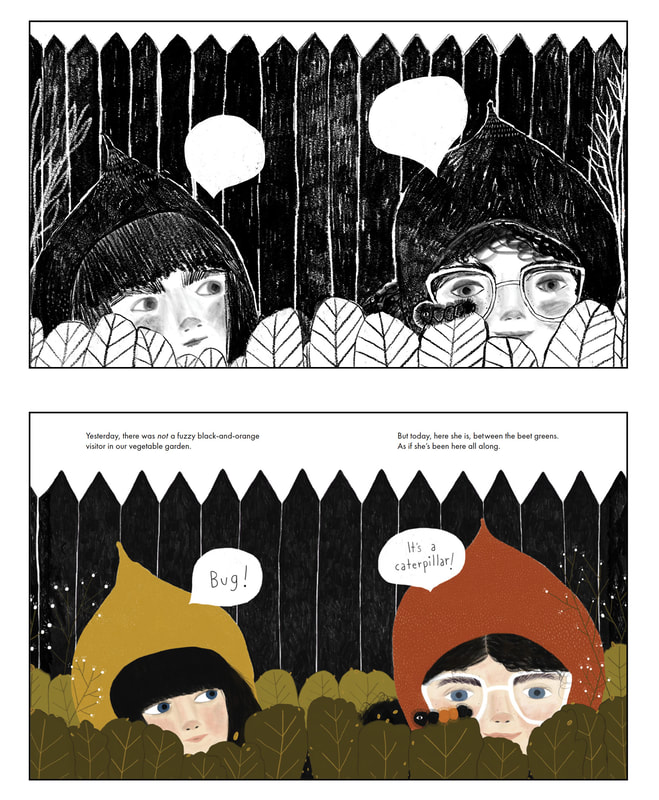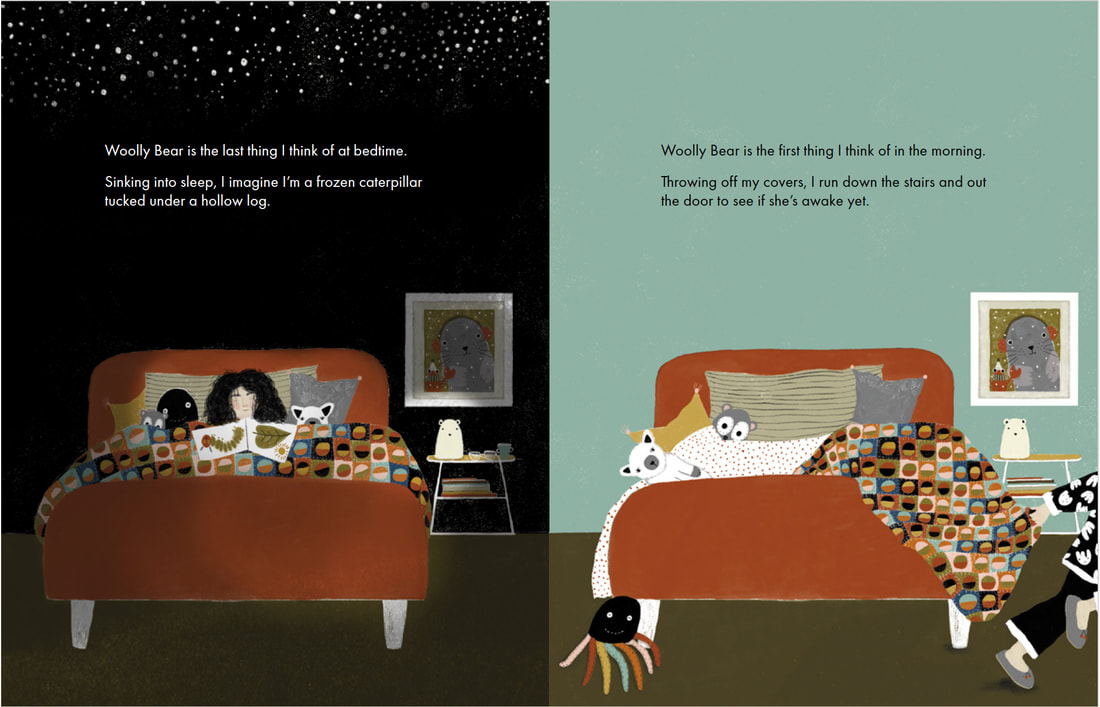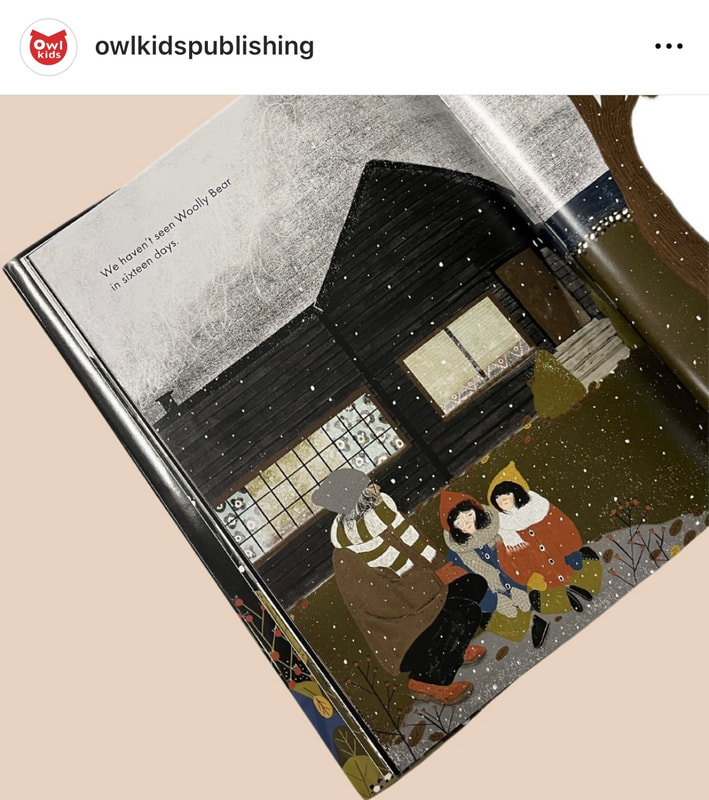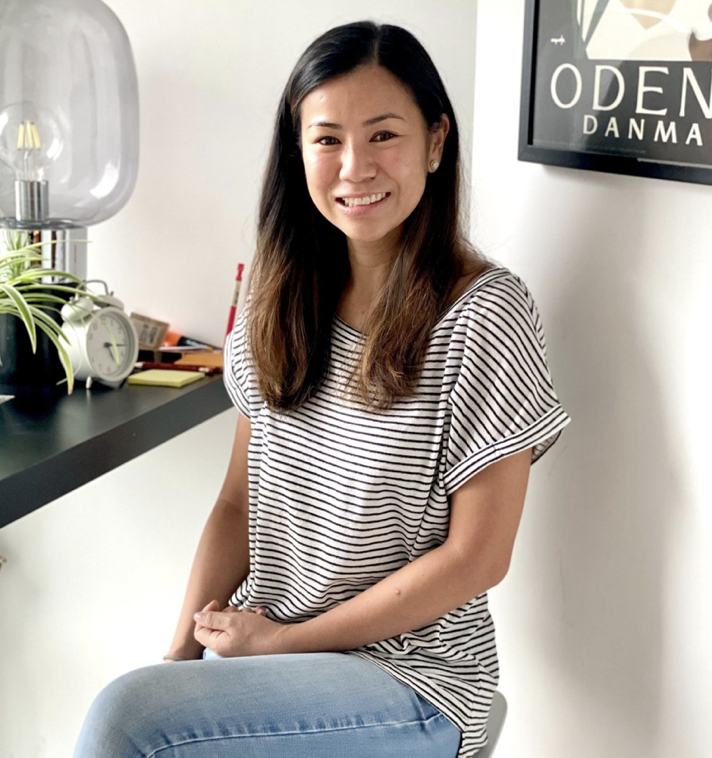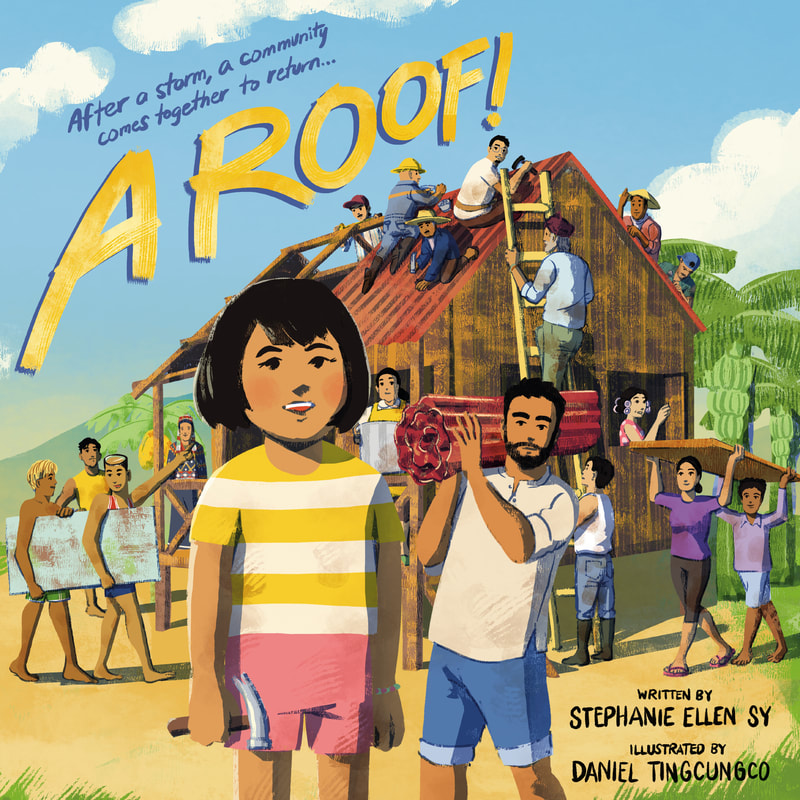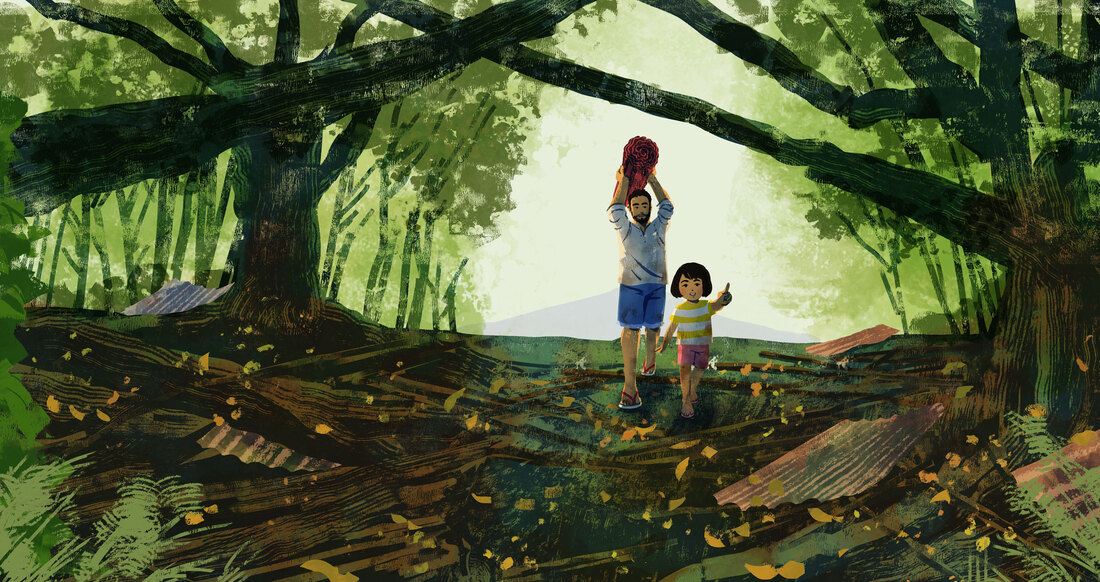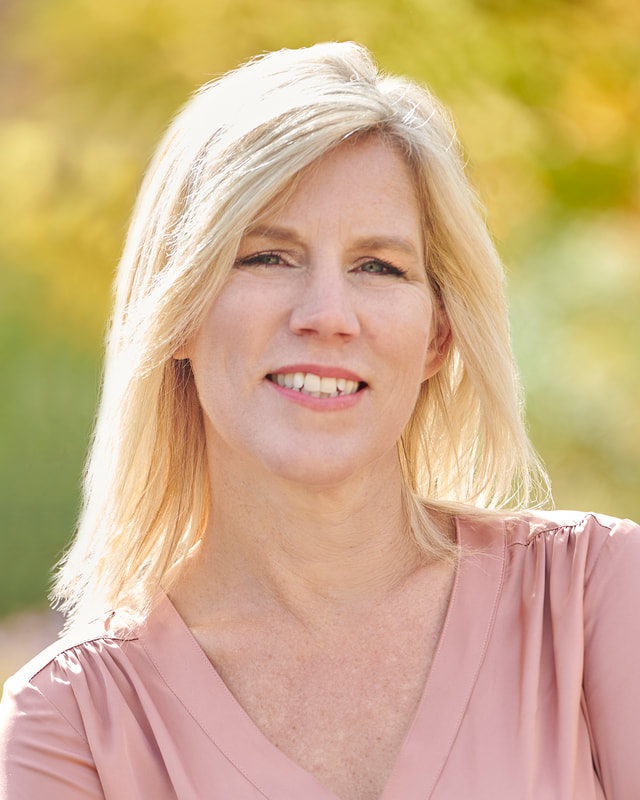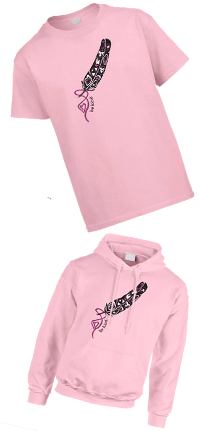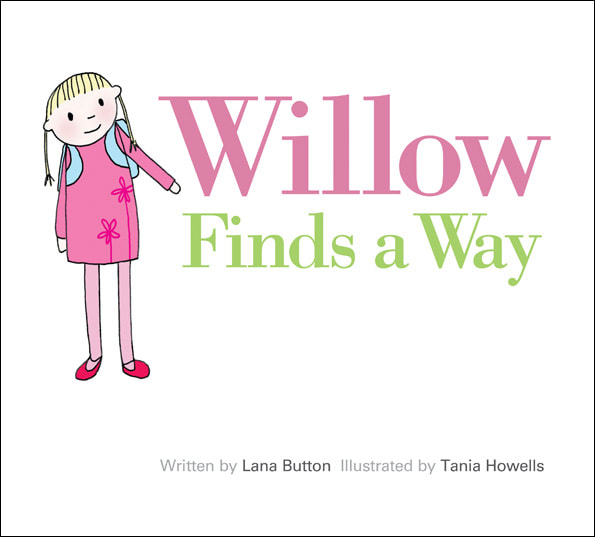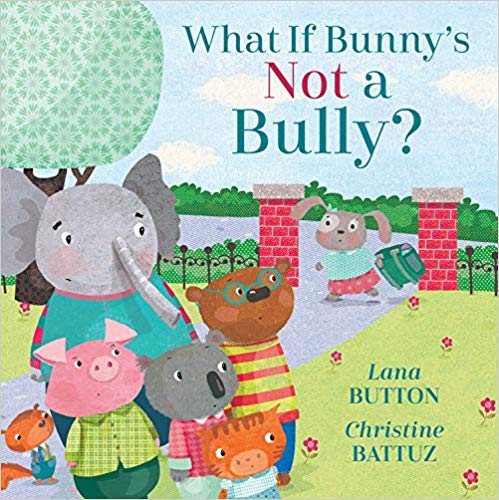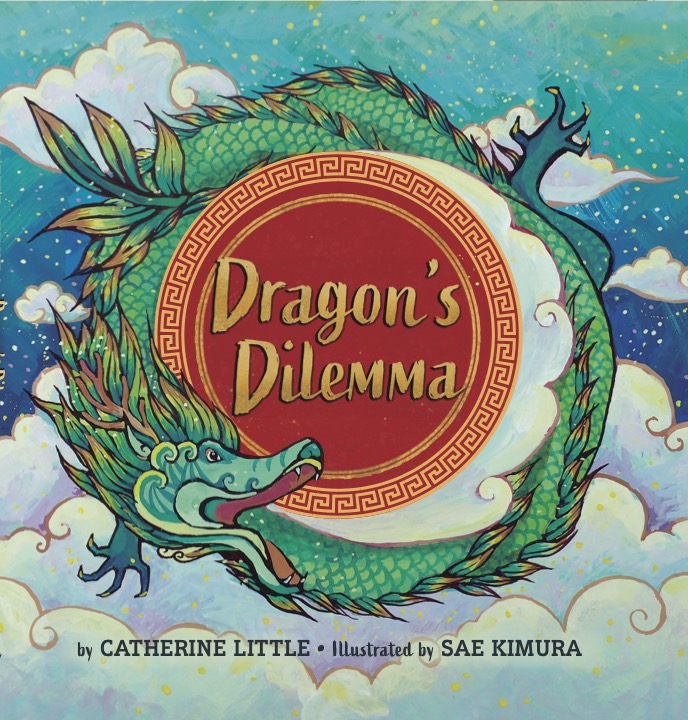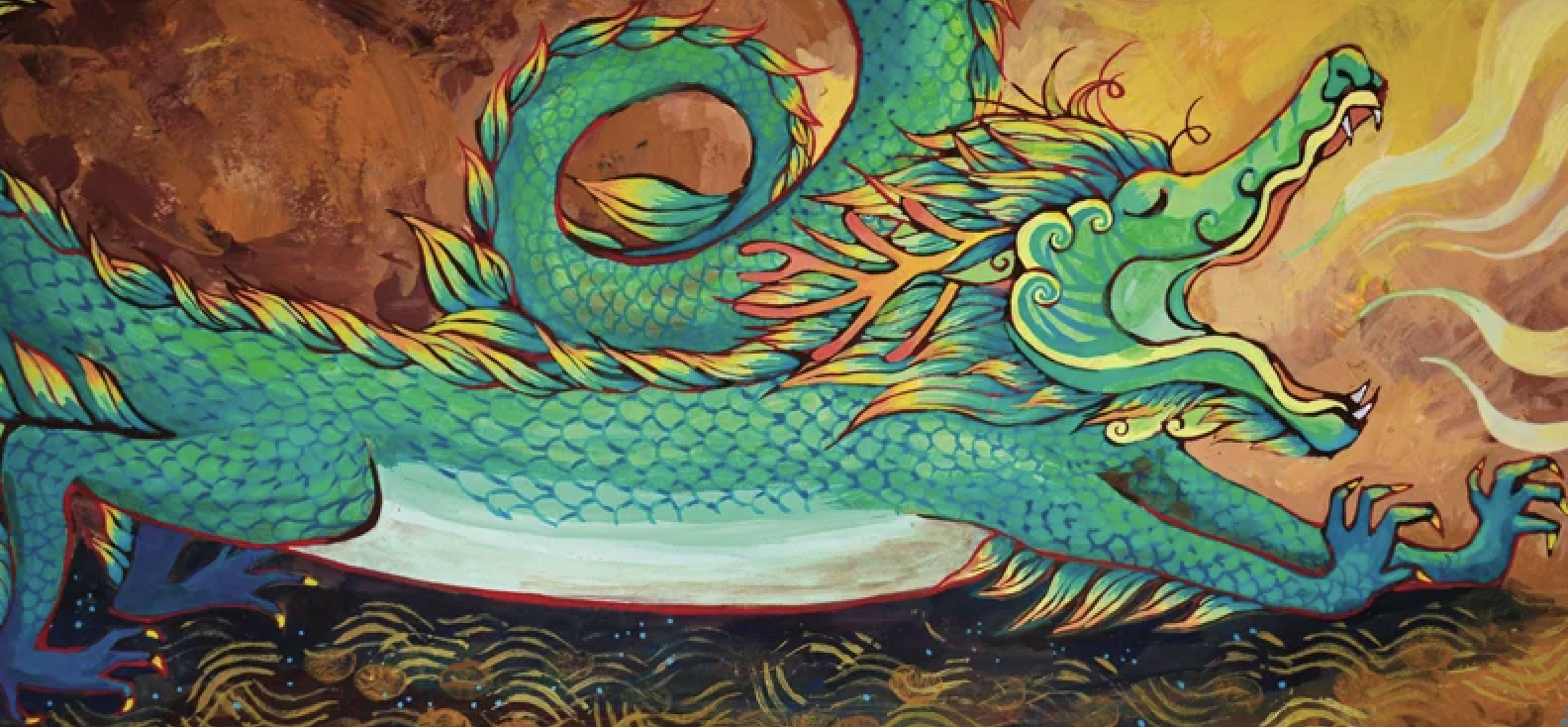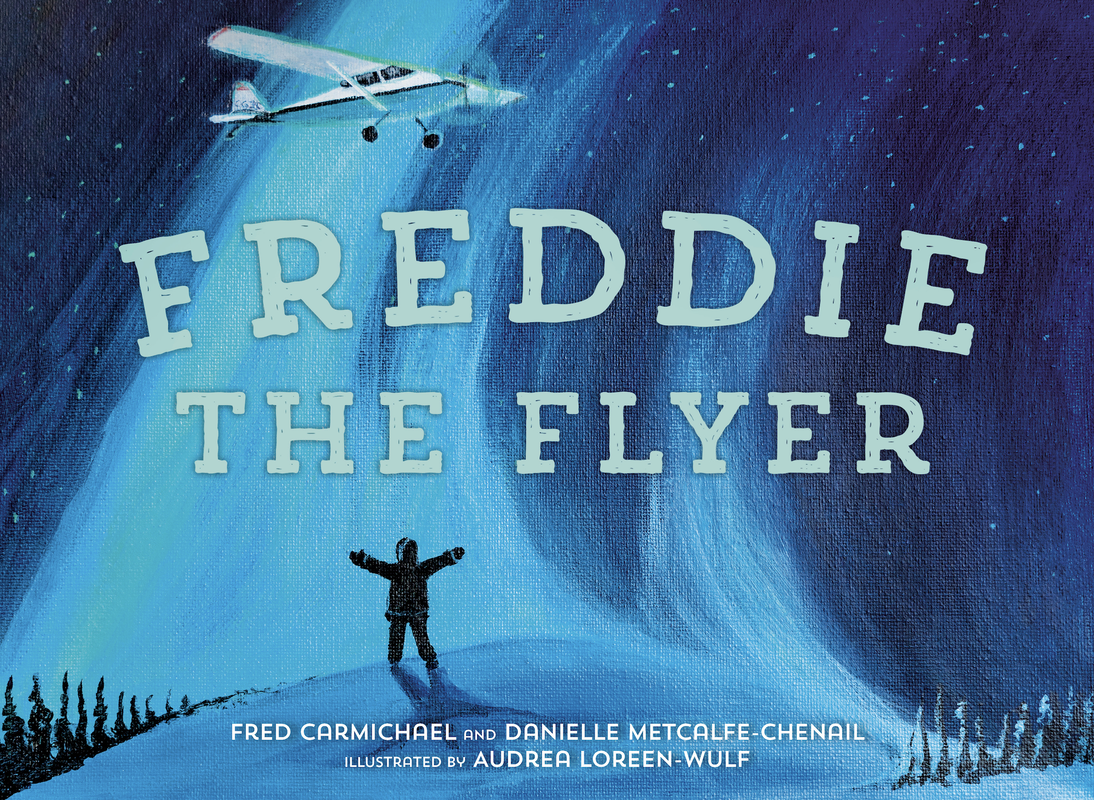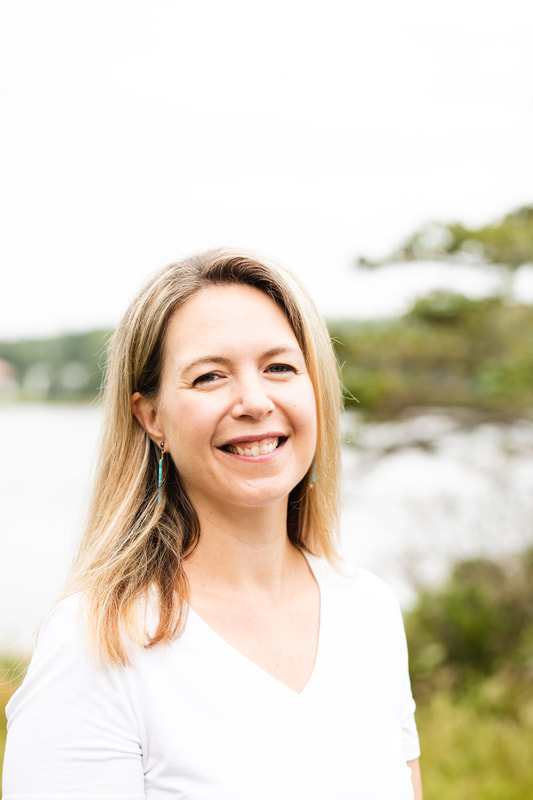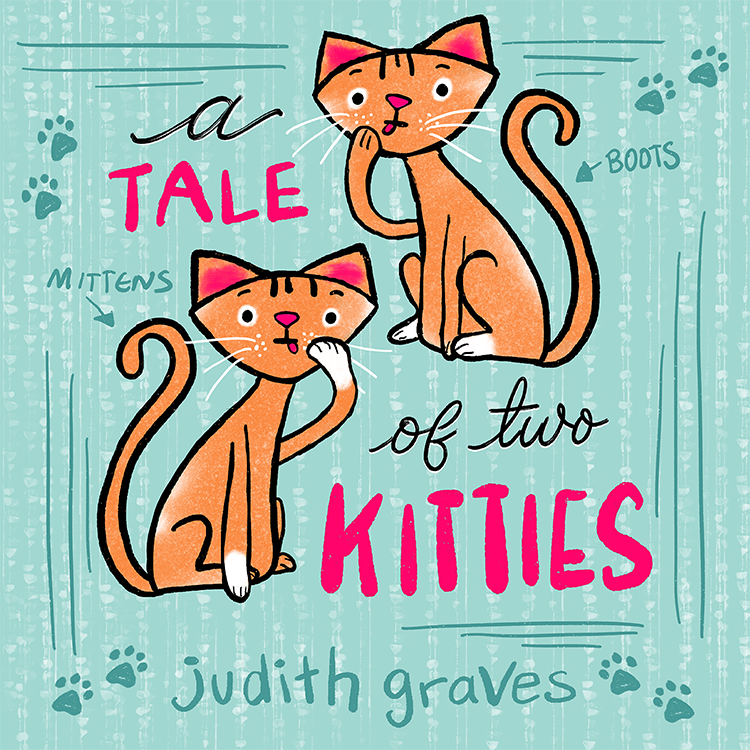|
MICHELLE I was working on my It Must Be Seasons series when this book quietly and unexpectedly crept up on me. My mother-in-law had been diagnosed with dementia a few years ago. Growing up, our children always loved it when their grandparents came to stay from Vancouver a couple times every year, but their most recent visits seemed different, and things started disappearing around the house. We eventually realized that lost keys, eyeglasses, cordless phones, and even soap dispensers were ending up in Oma’s bag. As we went through her collection nightly, she would tell us stories about each item. At around the same time, there was a day when we were having a particularly difficult morning with Oma. Opa turned to me, eyes brimming with tears, and said, “I feel like she’s slipping away.” At first, I couldn’t think of anything comforting to say. But later as I watched Oma happily watering my aloe plant every time she walked by it while the children laughed and joked with her, I was inspired to write my answer to Opa in the form of a book. Enter Sam. SAM Oma’s Bag is not only the first commissioned book I've illustrated but also my first book to be traditionally published! My desire to be an artist stemmed mainly from the copious amounts of comics I used to read as a kid such as Calvin and Hobbes and Peanuts. Illustration by Sam Nunez from Oma's Bag. MICHELLE Wow, Calvin and Hobbes is probably the first comic book my family ever owned and I still have a collection of Snoopy stuffies on a shelf in my bedroom! No wonder our partnership was so seamless, Sam. Actually, I knew that you were the right illustrator to go with when I gave you photos of my family and asked you to draw your version of us. I couldn’t believe how you were able to capture not only the physical resemblance but the overall essence of my father-in-law (and Oma and all the children as well, of course.) Illustration by Sam Nunez from Oma's Bag. Photo of Michelle's father-in-law. SAM Depicting the Lim children had to be one of my favorite parts of the process. As the youngest of four siblings I found the dynamic the children shared to be not only charming but very relatable. I found the themes of growing up and spending time with older relatives to be very touching and heartfelt and I hope my illustrations are able to do the same. Illustration by Sam Nunez from Oma's Bag. MICHELLE They absolutely do! And I am so grateful that you were able to because at the heart of Oma’s Bag is my family’s story. Since so many scenes in the book were from our own real-life experiences, I had very specific images in my head for how they should be illustrated. For other illustrations, I was inspired by my favourite picture books - I could imagine the contents of Oma’s bag as pages from the I Spy series. For the rest, though, I really had no idea how I wanted it to look. Luckily for me, you obviously did. Illustration by Sam Nunez from Oma's Bag. SAM The process of producing Oma’s bag was fairly straight-forward. I really like to plan ahead when tackling a project like this so I spent a significant amount of time with Michelle framing each page until it fit just right with her vision. The book was done 100% digitally using Corel Paint Essentials and my trusty drawing tablet. Progression of an illustration by Sam Nunez from Oma's Bag. MICHELLE Well, not 100%, or at least not initially anyways. I remember the first time we met in the children’s section of the Peterborough Public Library. I had just given you a copy of my manuscript and you were reading it surrounded by all these books we had pulled out as exemplars. We started talking about the ideas I had and you gave me your thoughts about some other pages. At one point we were stuck on a particular passage and we just started throwing out ideas to see what might stick to the wall. I looked up mid-sentence and you slid over a piece of paper with a detailed pencil sketch of everything we had just talked about drawn on it. I was just in awe. Pencil sketch by Sam Nunez of characters from Oma's Bag. SAM Illustration for me now is currently only a hobby, and while working with you to bring your vision to life was a blast I hope to someday soon branch into telling stories of my own. Until then I hope to continue illustrating children’s books and more! MICHELLE I can’t wait to read your books, Sam! In the meantime, hopefully we’ll work together again because this book was so much fun to do. I currently have a spin off adventure for the squirrels from my It Must Be Spring book writing itself in my head. I also have a fistful of stories inspired by pretty much anything and everything I see these days. Finally, who knows, Oma’s bag of tricks might not be her only one yet. Since I don’t see my own drawing talent getting better anytime soon, keep a tab open on the trusty tablet for me, Sam! Illustration by Sam Nunez from Oma's Bag. Michelle Wang lives in Toronto, Ontario, where she was born and raised on Saturday mornings at the library with her two sisters, borrowing ten books each. Unlike Oma, Michelle doesn’t usually carry around a purse or a bag, but please don’t ask to look in her pockets.
https://itmustbebooks.com/ (iG) @itmustbebooks (FB) @mustbebooks Sam Nunez is an artist with a love for illustration and cartoons. Oma’s Bag is his first book. He lives in Peterborough, Ontario. instagram.com/samnunezart My new picture book, WHEN YOU MEET A DRAGON (Orca Books) comes out this month. So I thought I’d pop by the Picture Books Eh! site to talk about my favourite part of the project. Cover of When You Meet a Dragon, by Tanya Lloyd Kyi, illustrated by Udayana Lugo (Orca Books) WHEN YOU MEET A DRAGON is the story of a small child who encounters an overwhelming problem. A ferocious dragon threatens the town. But a child can’t fight a dragon alone! So neighbours are roused, friends recruited. Even a few animals join the fight. And then... some people have other ideas. Interior illustration by Udayana Lugo from When You Meet a Dragon. I have to admit, when I wrote a page of dragon deniers into the book, I assumed the editor (in this case, the wonderful Sarah Howden) would make me take them out. But Sarah has a twisty sense of humour, and the dragon deniers remained. I chuckled to myself, then I forgot all about this crowd for the rest of the story. They don’t appear in the text after page six. But illustrator Udayana Lugo DID think more deeply about the dragon deniers. She called them in. Here’s one of them on page seven, reconsidering his position. Over the next few pages, he abandons his protest sign and he battles the beast, fights fires, and helps clean up the town. Interior illustration by Udayana Lugo from When You Meet a Dragon. I often tell my writing students to ensure they're telling a picture book narrative through both the text and the illustrations. In this case, Udayana took my text, expanded the story, and vastly improved it.
It takes a whole team to fight a dragon. It also takes a great team to make a picture book. I’m so grateful to Sarah and Udayana for bringing this one to life. Find me at www.tanyalloydkyi.com or on Instagram at @tanyalloydkyi. Tanya Lloyd Kyi is the author of more than 30 fiction and non-fiction books for children and young adults. She’s curious about everything from penguins to popcorn and she has more questions about the world than any scientist could answer. Tanya lives in Vancouver, B.C., where she teaches for the University of British Columbia’s School of Creative Writing. Do you remember the first palindrome phrase you ever learned? One that always impressed me when I was a child was Able was I ere I saw Elba. I couldn’t have told you a thing about Napoleon aside from the fact that he was exiled on the island of Elba, but I was fascinated by the way a palindrome could tell a story. Fast forward a few decades, and there I was, trying to use palindromes to tell a story myself. Like many stories, Was It a Cat I Saw? started with “I wonder.” One night, I was lying in bed (the drowsy space between waking and dreaming is my favorite for brainstorming), and the name Hannah crossed my mind. How fun that it’s a palindrome, I thought. I wonder how a kid named Hannah could live a palindrome-filled life. I wonder … how many words are reversible Step one: palindrome research! From simple words like “wow” and “toot” to longer phrases like “goldenrod-adorned log,” there were so many incredible and reversible words to choose from! It was important to me to maintain a sense of cohesion between the choices. Still, it’s fun to imagine what turns the story might have taken with a different set of palindromes! What adventure might have led Hannah to say phrases like No Stetson or Drat! Such custard! along the way? I wonder … how to start over Early drafts of Was It a Cat I Saw? were shaped around an unconventional structural gimmick. And it wasn’t working. The palindromes felt forced, the language was stilted to make it fit the structure, and one pirate-based plot point was refusing to work the way I needed. When I’m not writing picture books, I edit them, and I was breaking one of my biggest “rules”: don’t let the structure compromise the story. It was clear that I needed a new approach. Once I decided that Hannah would speak only in palindromes, everything fell into place. The final touch was a nod to my original idea of a palindrome-like structure. I mapped out the story so that Hannah’s quest through town follows a forwards-and-backwards path, giving a sense of symmetry to the narrative. Hannah’s new friend enlists her help finding his lost cat. From Was It a Cat I Saw? (Laura Bontje and Emma Lidia Squillari; Amicus Ink 2024). I wonder … who I’m supposed to be
When I wrote my first picture book draft, I envisioned myself as the author of lyrical, reflective books—books like my upcoming 2025 release, When the Air Sang. But Hannah’s love of palindromes kept tickling my imagination, so I took a “side quest” to explore this quirky, wordplay-filled story. In the midst of querying agents, Was It a Cat I Saw? jumped the queue and got an offer of publication via #PBPitch from Amicus Ink. And I’m so glad it did—not only because my dream of becoming an author came true, but because it reminded me that the restrictions on my writing style were ones I had created. I do write lyrical, reflective books. I also love quirky books and witty wordplay. Our language feels limitless, so I’m not going to limit myself to one idea of who I should be as an author. Back to the beginning A palindrome goes forwards and backwards. When I wrote Was It a Cat I Saw, I reached backwards through time to bring forward one other palindrome phrase that delighted my younger self. I love how it fits into the end of the story, tying the kids’ experiences together. It’s not Able was I ere I saw Elba. It’s not A man. A plan. A canal. Panama. What is it? Well, you’ll have to read the book and find out! Laura Bontje (she/her) is a freelance fiction editor who specializes in children’s literature. Her palindrome-packed debut picture book, Was It a Cat I Saw? (illustrated by Emma Lidia Squillari), was released on March 12, 2024, from Amicus Ink. In 2025, she’ll introduce children to the magic of cicadas with her second picture book, When the Air Sang (Annick Press; illustrated by Sarah Whang). Laura grew up in Calgary and now lives in London, Ontario, with her husband and two young kids. Learn more at laurabontje.com or @LauraBontjeBooks So Loud, by Sahar Golshan, illustrated by Shiva Delsooz (Annick Press) My debut picture book So Loud! hits bookstore and library shelves today in Canada with Annick Press. So Loud! is illustrated by Shiva Delsooz. One of the thumping hearts of this story is a badass, joyously loud diasporic grandmother. Māmān Bozorg, the Persian word for grandmother and the name of the character in question, was present in every draft of the book. And still, I wasn’t always certain about her place in this fictional story. Is my book playing into a trope? Grandparents, and grandmothers in particular, abound on the pages of children’s picture books. A hilarious photo from a Lit Hub article called “Let the Kids Get Weird: The Adult Problem With Children’s Books” by Janet Manley comes to mind. The image is a collage of nine books. Eight of the nine books are about both grandmothers and gardens. The ninth is simply a garden book: one a grandmother might buy for her grandchild. I hadn’t seen the image or read the article when I was revising the text of my book, but I had my own unique spiral of inquiry. Is the diasporic grandparent a cliché in picture books? If so, should I change my story in order to go against the grain? Cliché or cultural cornerstone, what unique role can a diasporic grandparent play in the life of a diasporic child? In the early stages of writing, I discussed my many diasporic-grandparent-picture-book questions with my editors Khary Mathurin and Claire Caldwell. On a Zoom editorial call, I wondered out loud. “Does the world really need another picture book about a girl and her grandmother?” Today my doubts about the power of the diasporic grandparent in picture books have waned. My thinking has changed. Abuelita and Me, by Leonarda Carranza, illustrations by Rafael Mayani A meaningful part of this shift has come through reading books like Abuelita and Me. Full transparency: Abuelita and Me is an Annick Press book, just like So Loud! Its placement in this blog post is not a promotion, but rather a genuine reference to my reading list as I wrote my book. While I wrote So Loud! I spent my days walking to and from my local library, hauling stacks of wide and mighty picture books. In Leonarda Carranza and Rafael Mayani’s work, a girl and her abuelita rely on one another as they navigate racism while moving around their city. On an Instagram live reel, writer Leonarda Carranza spoke about how the loving relationship between the grandmother and the young narrator help them contend with the racism they experience on a bus. In the months leading up to the publication of So Loud! I read 100 Chapatis. In Derek Mascarenhas and Shantala Robinson’s book, a boy and his grandfather make one hundred chapatis as they wait for the arrival of the boy’s new baby sibling. I attended the launch for this book. Writer Derek Mascarenhas spoke about how important it was to tell a story featuring a boy and his grandfather: two masculine people of two different generations cooking chapatis in a kitchen together. 100 Chapatis, by Derek Mascarenhas, illustrated by Shantala Robinson Like Abuelita and Me and 100 Chapatis, many of these books featured dynamic diasporic and Indigenous grandparents.
Some of the titles included: Our Woolly Bear, by Katie Arthur. Published by OwlKids Books. Out in March 2024. I started thinking about the story that would become Our Woolly Bear three and a half years ago. We were still in the first wave of the pandemic, and my kids were one and three. As anyone with small children can tell you, you are never not busy when you’re caring for them. Even when you are technically not “doing” anything, you are always doing something. Usually five somethings. Usually all at once. It’s the absolute best, but… it also leaves very little time for much else. And yet somehow in the small moments between making snacks, and collecting rocks, and singing songs, and sweeping crumbs, and snuggling tiny humans to sleep, this book was born. Or at least the idea for it was. Rough sketch to final art I’ve been writing and drawing stories as long as I’ve been able to read them. Thirty years! There’s really no other activity that’s been so constant in my life. Nothing I can retreat to and find peace in quite like inventing a fictional world. But somehow it took me decades to actually focus my attention on a single project, see it through, and work up the courage to show it to someone who could make it real. Part of this is surely the pandemic effect that so many of us felt: a sudden urge to revaluate priorities and seize the moment. The now-or-never of it all. But it’s also the case that in having less time (way less time) for creative projects, I was able to bring a new kind of focus and clarity to the work. I stopped caring about what other people might think. I stopped caring about whether my stuff was good (or, worse, whether it was “sellable”). I didn’t have time to listen to the voice that’s always been in my head, fretting about whether I’m talented enough or smart enough or interesting enough. I used to feel like I needed an invitation to be a real artist. But that feeling now seemed enormously dumb. When I would finally have a second to myself in those days, I would just work. I would create like I used to when I was a kid, back when writing and drawing was something I did without interrogating what it was for. All I knew is that I had to do it. And so I did it. Final art from Our Woolly Bear (also my favourite spread). Early drafts and illustrations for Our Woolly Bear were largely completed between the hours of 8pm and midnight. I’d balance my art supplies and my iPad on my lap in front of the TV, or spread out at the dining room table. It wasn’t the idyllic way I’d imagined making a book. But before long, it was habit. I had a schedule—one I sincerely looked forward to (exhausted as I was). Fast forward a few years and a lot changed. My book found a publisher, and I was finally making final art. Yet my work schedule stayed pretty much the same. There was the occasional naptime or weekend afternoon where I could steal away for a few hours. But mostly, I kept working the night shift. It shocked me how much I could accomplish in a week if I chipped away at it, page by page, a few sleepy hours at a time. I’m almost finished my second book now, and I’m still working on various strategies to slot my work as an author/illustrator within the bigger puzzle of professional and family responsibilities. Do I routinely fall asleep with a pencil in my hand? You bet! But I’m also so glad I’ve stopped waiting for the right moment to finally get serious about making art. I really wish someone had told me when I was younger that there is no such thing as the perfect conditions for a creative life. You just have to build it into the life that you’re currently living, right now, and see what happens. No invitation required. And if you ever need a little extra motivation, feel free to send me a message. I’ll be up late. A real, live book! Our Woolly Bear comes out on March 15 and there are some links here if you’re interested in buying a copy.
Katie Arthur is the author/illustrator of Our Woolly Bear (March 2024) and Marty is Coming To My Birthday Party (Spring 2025). She holds an MA in English Literature and Creative Writing from Concordia University and is a graduate of the Humber School for Writers. In addition to picture books, she is working on a middle grade graphic novel. Katie lives in Malignant Cove, Nova Scotia. For more information, please visit www.studioarthur.com. I remember the exact moment when I wrote A ROOF! It was January 1st, 2022, and I had just received my second COVID-19 shot. Unlike the first one, this vaccine knocked me out, leaving me in bed all day, with time to catch up on the news. The headlines were all about the heart-wrenching aftermath of Typhoon Rai in the Philippines. It was a reminder of how devastating natural disasters are sadly common in my part of the world. So, lying in bed, I began typing away, jotting down A ROOF! in my notes on my phone. Growing up in the Philippines and Hong Kong, I have witnessed firsthand the destructive force of typhoons and the havoc they can wreak. As a child, I vividly recall the meticulous process of taping Xs on our windows on the 33rd floor, preparing for the potential shattering. Just last October, Hong Kong was hit by back-to-back typhoons and heavy rainfall, leading to widespread flooding that even affected the subway stations. I have personally witnessed the resilience of friends and communities in the Philippines as they faced the daunting task of rebuilding, relocating, or repairing their storm-damaged homes. In rural and impoverished areas, where roofs are often made from flimsy corrugated sheets, losing a roof is an all-too-common occurrence. It is even more disheartening that some communities expect such losses so frequently that they inscribe their names and addresses on their roofs, hoping for their eventual return. This became the premise of my story. In A ROOF!, the main character Maya stumbles upon a roof in her backyard and realizes that there must be a desperate family out there yearning to reclaim it. Inspired by the cumulative style of THANK YOU, OMU! by Oge Mora, I knew that I wanted to incorporate a similar approach in A ROOF!, as it would beautifully showcase the sense of community within the story. The narrative delves into themes of resilience and unity, drawing upon the remarkable bayanihan spirit—a cultural trait deeply ingrained in Filipino society, which emphasizes collective effort for the greater good, particularly in times of disaster. This spirit serves as the driving force behind the story, which unfolds as a cumulative tale following Maya's journey. Alongside her father, Maya sets off on a mission to return the roof to its rightful owners, encountering new friends and receiving helping hands along the way. Maya and Tatay journey through a forest with the roof they discovered in their backyard, illustrated by Daniel Tingcungco (Kokila) Maya's expedition takes her through a diverse array of landscapes found in the coastal areas of the Philippines, ranging from majestic mountains to serene mangroves and lush forests. Daniel Tingcungo beautifully captures the magic of the Philippine islands and breathes life into the story with his captivating illustrations. Today, I am proud to reveal the cover, prominently featuring Maya and her father standing in front of the house they are helping to rebuild.
My debut picture book, A ROOF!, illustrated by Daniel Tingcungco and published by Kokila, is scheduled for release in September. In the world of publishing, seven months is considered right around the corner, and I can hardly contain my excitement. The preorder link is now officially live! Stay tuned for more updates as we approach the release date! Stephanie Ellen Sy is a writer and interior designer with a degree in International Relations and Asian Studies from Tufts University. She draws inspiration from her memories and experiences living in Hong Kong, Canada, the US, Italy, and the Philippines, where she was born. She now splits her time between Vancouver, British Columbia, and Hong Kong. http://www.stephanieellensy.com Pink Shirt Day is coming up. On Wednesday, February 28, students across Canada will wear pink shirts to elementary school, and pledge to stop bullying. So, who exactly is this bully? As an early childhood educator and a picture book author, I am coming at this conversation focusing on our kindergarten to primary grade pink-shirt-wearing students– and I am not a fan of name-calling. Pink Shirt Day is about being kind, standing up for a friend, and speaking out when we see unkind behaviour. And I would add- that we need to leave space for our peers and ourselves to acknowledge that we’ve made a mistake, that we’re sorry, and we’d like to try again. Elementary school is not made up of ‘good guys’ and ‘bad guys’ it is made up of children developing (and making mistakes along the way with) their communication, language and social skills. My picture book, WILLOW FINDS A WAY (Kids Can Press, illustrated by Tania Howells) was placed on several bullying awareness lists, including Publisher’s Weekly, and the CCBC Pink Shirt Day List. It’s about how the quietest kid in class stands up to someone being unkind. But the story doesn’t end when the class follows Willow’s lead and crosses their names off Kristabelle’s birthday list. It doesn’t end with everyone turning their back on this primary-grade kid. It ends after Willow once again walks away from unkind behaviour, and gives Kristabelle some grace and some space to try again. . Willow Finds a Way (Kids Can Press) by Lana Button and Tania Howells I think we can get to the other side of bullying, where every child feels safe, respected and heard, by helping children develop these three skills: Communication Skills If you’re a bully you’re bad. That is the Coles Notes of what children are told. Stand up to them. Absolutely, we must flex our communication skills to tell people when they are treating us, or those around us badly. Teaching kids to use action words when communicating with their peers can help. “Don’t call me that.” Is a specific direct action that is a lot more helpful than ‘you’re so mean.’ And it takes practice! Sit in on any marriage counselling session to remind yourself that adults are still working on it. It’s also very helpful for children to express how that action makes them feel. “That makes me really sad when you do that.” This healthy communication allows a child to acknowledge their feelings, and it helps them develop their ‘feelings vocabulary” (ie: ‘that frustrates me’ ‘that embarrasses me’) Okay, but what if a child acknowledges that they are the ones who have been unkind? Are they a primary grade kid who is “doomed to be a bully, with no chance to make it right?” as Kitty says in my picture book WHAT IF BUNNY’S NOT A BULLY? (Kids Can Press, illustrated by Christine Battuz) Let’s add to the phrase, “I’m sorry,” which can often get tossed around like a meaningless magic word. If there’s a breath there first, and an acknowledgment, with some action words, “I made a mistake when I said that.. when I did that..etc. I’m sorry.” It is healthy to acknowledge when talking about unkind behaviour, that we all make mistakes along the way. What if Bunny’s Not a Bully? (Kids Can Press)
by Lana Button and Christine Battuz February 10th, 2024 marks the transition from the Year of the Rabbit to the Year of the Dragon. My latest picture book, Dragon’s Dilemma, tells the story of the zodiac race from Dragon’s perspective and is a companion piece for Twelve in a Race. When my now 21 year old son was about 4 or so, I looked for a picture book to help him learn about The Great Race but didn’t find anything that was suitable for his age. I wrote the rhymes for Twelve in a Race but didn’t find a publisher interested in my story until 2020. Twelve in a Race became my debut picture book. After it was finished, my publisher, Maggie Goh of Plumleaf Press, and I looked forward and realized 2024 would be the Year of the Dragon - a really big year - and decided a dragon story was in order. Dragon’s Dilemma tells the story of The Great Race from Dragon’s perspective, answering a question children often posed after I read them Twelve in a Race. They wanted to know how Dragon - the biggest, fastest and only contender who could fly - ended up in fifth place. Illustration by Sae Kimura, courtesy Plumleaf Press When I wrote the story I drew on traditional characteristics of Chinese dragons. Unlike Western dragons, the Dragon of my story would not breath fire or kidnap hapless villagers. Instead, Chinese dragons were said to control weather and water and often brought rain. Chinese dragons were said to be noble creatures and signified good luck. In order to explain why Dragon didn’t just fly straight to the finish line and win the race I drew on another Dragon characteristic - over confidence.
I was reunited with illustrator Sae Kimura for Dragon’s Dilemma and we are delighted with how it turned out! Catherine Little is an experienced educator, writer and consultant. During her career, she has taught in P/J/I classrooms as well as for the Faculty of Education at York University. Her writing can be found in newspapers, professional journals and textbooks. Most recently she has turned her attention to writing picture books that celebrate Chinese culture and illuminate contributions. Her titles include Twelve in a Race, Endgame: The Secret Force 136 and Dragon’s Dilemma. CBC included Endgame: The Secret Force 136 in their 2023 list of 11 Books Canadian should read for Remembrance Day. Follow me on Instagram @books.beyond.bedtime www.instagram.com/books.beyond.bedtime/ When I first met Fred Carmichael in November 2010, he was seated at a small table in a restaurant in his hometown of Inuvik, Northwest Territories. I shuffled up to him in my bright blue parka, egged on by a new pilot acquaintance who happened to be related to Fred. “You have to meet him,” my friend said. “He’s a legend.” I can’t remember what I mumbled at Fred in my shyness. I was writer-in-residence at Berton House in Dawson City, Yukon, but I was 28 years old and my imposter syndrome was raging. I know I gently placed a copy of my first book on the table as an offering and then probably turned and fled. I don’t even know if I saw the characteristic twinkle in Fred’s eyes that first time, I looked at the floor so much. Luckily my book – For the Love of Flying - made a better first impression, and Fred agreed to talk with me for my research on northern aviation. I don’t think either of us imagined we’d keep in touch so much over the years, and that by 2019 he would let me talk him into creating a picture book about his inspiring life. Even if it was begrudgingly at first. Often in flying circles pilots are known as story spinners, adventure relivers, and even, at times, full-on BS-ers. “Hangar flying,” I’ve heard it called. But Fred was different. He had been a pioneer of aviation, business and leadership in his community and Canada. But he was humble, careful, and, it turned out, naturally shy like me. So it took some prodding from his amazing wife, Miki, and me, a whole lot of meals (and desserts) together, a memorable dogsledding trip, and many, many checks of the picture book text to make sure it was flight-worthy. Fred paid the book the same care he paid every time he went up in his 70 years of flying, doing his walk arounds, checking fluid levels, and triple-checking his instruments. That attention paid off. Thirteen years later, we have an amazing book to inspire kids to dream big and follow their hearts into the sky and beyond. And this shy southern writer found her warm Inuvik family. Danielle Metcalfe-Chenail is the author of six books for adults and children, including the bestselling picture book Alis the Aviator (Tundra Books). In Fall 2023 Danielle released a co-authored picture book biography called Freddie the Flyer (Tundra Books) featuring the first Indigenous commercial pilot in the Arctic, Fred Carmichael; a paperback edition of Alis the Aviator; and an inclusive paranormal timeslip chapter book called Fever on the Forgotten Coast. Danielle lives in a fog-filled bay in Nova Scotia with her spirited kids, crazy dog, and seafaring husband. www.daniellemc.com As a library technician, I worked in school, public, and law libraries for over twenty years. I learned a key thing while in those various library settings.
Kindergarteners cry less than lawyers. Of course I’m joking (kinda). But this brings me to the topic I’d like to explore: why funny reads are PURfectly serious. Specifically, I’m talking about humorous picture books and my time working in an elementary school library (AKA the day job), but my thoughts on stories with laughs apply to adult fiction and adult readers as well. Indeed, up until now, I have been writing horror/thriller/action novels for young adults, with dark comedic moments, sure, but also filled with scares and blood and moments of dread. So, yeah, my debut picture book, A Tale of Two Kitties, has been a first for me on many levels:
Anyway, getting back to the topic…Why stories with laughs are heavy hitters in my books. Reading picture books to elementary school classes, all week long, on warm spring days when they’d much rather be outside, and on freezing winter ones when they were stuck inside, I discovered the best way for me to wrangle in the kiddos was to hook them with laugh-out-loud reads. Thanks be to writers and illustrators who do humour well. A funny story can capture those little souls for a few glorious minutes of belly laughs. It can spark interest in something new, inspire a struggling reader to seek out more books by that author or illustrator. Or it can simply give a child a much-needed boost. That’s powerful, serious stuff. I wanted to write and illustrate those kinds of stories. Because laughing matters. But I was like Mittens and Boots in KITTIES, comfortable in my little writing world and not sure I wanted things to change. At first I took baby steps, just like those two contrary cats, and soon my skills improved by leaps and bounds. It took years of writing and sketching and scraping pieces and starting again, but I don’t regret stepping out of my comfort zone. Not one bit. I haven’t abandoned horror like it was an old cabin in the woods. I’m still writing scary tales. I just have more options when it comes to storytelling. More room to swing a cat, so to speak. Speaking of, I can’t believe A Tale of Two Kitties is ready to pounce onto bookshelves. Life’s funny like that, eh? ~~ Thanks for reading! Now for the authorly things. Here’s the KITTIES book trailer if you’d like to have a boo: https://www.youtube.com/watch?v=bhhoZwUbNJ4 Follow me on Instagram: https://www.instagram.com/sassylassiedesigns/ My website: https://judithgraves.com/ Judith Graves is an award-winning young adult fiction writer (Exposed and Infiltrate: Retribution Series with Orca Book Publishers) as well as a screenwriter and illustrator. A firm believer that fiction can be action-packed, sassy, and yet hit the right emotional notes, Judith writes stories with attitude. She lives in Summerside, Prince Edward Island with her husband and fur-babies. A Tale of Two Kitties is her debut picture book. |
Picture Books, Eh!We write, illustrate and support Canadian, and we're releasing picture books in 2024! Follow us for news on Canadian PBs, regular blogs by Canadian PB creators, and more. |

